#Atbara
Text
Exporter of Belt Conveyor In Sudan
Exporter of Belt Conveyor In SudanR Mech Machines LLP established in 2008 in Ahmedabad, Gujarat, India, has emerged as a global leader in manufacturing, supplying, and exporting Belt Conveyor and other related products.The main purpose of our belt conveyors is material handling.You can use either the side working tables or the conveyor belt for quick assembly.We construct conveyors based on process requirements, considering the load weight and size of the commodities that need transport.The Types of Belt ConveyorsRoller Bed Conveyor Belts
Flat Belt Conveyors
Modular Belt Conveyors
Cleated Belt Conveyors
Curved Belt Conveyors
Incline/Decline Belt Conveyors
Sanitary and Washdown Conveyors
Specialty Conveyor BeltsSpecificationUsage/Application: Industrial
Belt Width: 600 mm
Brand: R Mech
Belt Thickness: 10 mm
Features: Heat, Chemical Resistant
Finish: Color Coated
Load Capacity(Kg): 180 kg/Feet
Voltage: 240 V
Automation Grade: Semi Automatic
Voltage (Volt): 220/380 V
Body Material: Mild Steel
Belt Material: Rubber
Frequency: 50-60 HzFeaturesLow energy consumption
High reliability and less maintenance
Heavy duty idlers with anti-friction bearings to increase idler life and reduce horsepower requirements
Heavy duty frames and structural supports to provide system rigidity
Easy to install
Zero speed switch
Our Belt Conveyors are used for grains, fertilizer, aggregate, cement, chemical, mining conveying and elevating.RMech Machines LLP is Exporter of Belt Conveyor In Sudan and various locations like
Khartoum, Omdurman, Khartoum North, Port Sudan, Kassala, Al-Ubayyid, Al-Fashir, Wad Madani, El Geneina, Atbara, Dongola, Rabak, Sennar, Kaduqli, Ed Damer, El Obeid, Medani, Kosti, El Fasher.If you are interested in our high-quality products, please do not hesitate to reach out to us for further information.
Read the full article
#Al-Fashir#Al-Ubayyid#Atbara#BeltConveyor#CurvedBeltConveyors#Dongola#EdDamer#ElFasher#ElGeneina#ElObeid#Exporter#ExporterofBeltConveyorInSudan#FlatBeltConveyors#Incline/DeclineBeltConveyors#Kaduqli#Kassala#Khartoum#KhartoumNorth#Kosti#Manufacturer#Medani#Omdurman#PortSudan#RMechMachineLLP#Rabak#Sennar#Sudan#Supplier#WadMadani
0 notes
Text
GWR City Class - City of Hobart
No: 3404 | True Name: Sion
Cowardly but loyal, Hobart is Truro's close friend. He often gets dragged into Truro's hair brained schemes and the two of them often end up getting into trouble with the Railway Authorities.
Hobart was rebuilt from the Atbara Class into a city class but because he was teased and bullied by his siblings as an Atbara and so wholeheartedly embraced his new class and rebuild as opposed to his other siblings.

#i could not find any photos of hobart so have Atbara instead#ttte broken records#ttte young iron#ttte city of truro#ttte city of hobart
12 notes
·
View notes
Text

Via NasAlSudan
Learn about the Sudanese revolution, the significance of December 19, and a legacy of resistance and resilience.
Join our call to action today and everyday during Sudan Action Week.
December 19 2023

Transcript:
Breaking it down
What is the Sudanese Revolution?
The Sudanese Revolution refers to the popular uprising in Sudan that began on December 19, 2018 and eventually deposed 30-year dictator of Sudan, Omar al-Bashir, on April 11 of 2019.
How did the Revolution begin?
Protests first began in Atbara, a city with historical significance to the labor movement in Sudan, in response to the rising costs of basic supplies such as bread and fuel.
Protestors set fire to the national party headquarters, and the news of their revolt quickly spread, inspiring protestors first in other cities, and then in the capital of Khartoum itself.
Online, the caption #TasgutBas, translating to #JustFall, grew in popularity and helped connect the diaspora to those in Sudan.
Was it really just bread?
No. The rising cost of bread in developing nations is an indicator of how badly the economy is strained, to the point where it impacts members of every social class.
At this point in time in Sudan, subsidies on essential goods had been rolled back, funding for social and state services such as healthcare and education was nearly nonexistent, and it is estimated that nearly 90% of economic activity took place in the informal sector, all while the military budget continually increased.
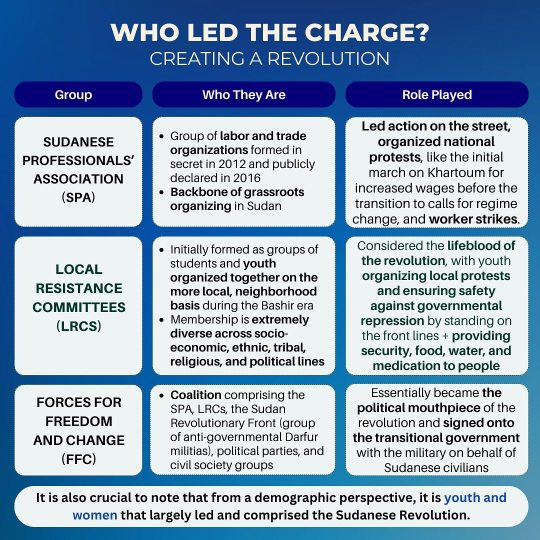
Transcript:
Who led the charge? Creating a revolution
Group: Sudanese Professional's association (SPA)
Who they are:
Group of labor and trade organizations formed in secret in 2012 and publicly declared in 2016
Backbone of grassroots organizing in Sudan
Role played:
Led action on the street, organized national protests, like the initial march on Khartoum for increased wages before the transition to calls for regime change, and worker strikes.
Group: Local Resistance Committees (LRCS)
Who they are:
Initially formed as groups of students and youth organized together on the more local, neighbourhood basis during the Bashir era
Membership is extremely diverse across socio-economic, ethnic, tribal, religious, and political lines
Role played:
Considered the lifeblood of the revolution, with youth organizing local protests and ensuring safety against governmental repression by standing on the front lines + providing security, food, water, and medication to people
Group: Forces for freedom and change (FFC)
Who they are:
Coalition comprising the SPA, LRCS, the Sudan Revolutionary Front (group of anti-governmental Darfur militias), political parties, and civil society groups
Role played:
Essentially became the political mouthpiece of the revolution and signed onto the transitional government with the military on behalf of Sudanese civilians
It is also crucial to note that from a demographic perspective, it is youth and women that largely led and comprised the Sudanese Revolution.
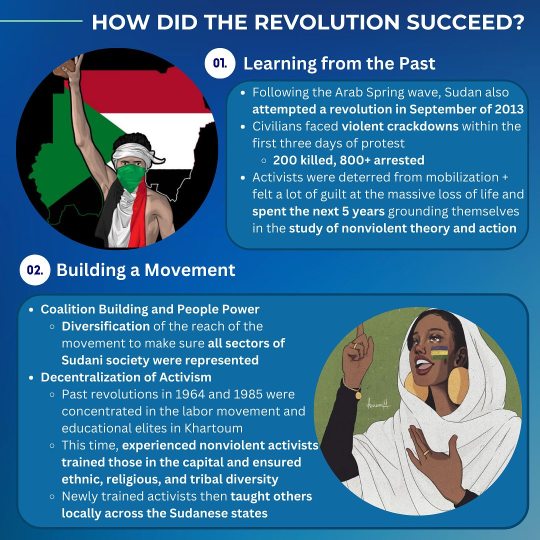
Trabscript:
How did the revolution succeed?
01. Learning from the Past
Following the Arab Spring wave, Sudan also attempted a revolution in September of 2013
Civilians faced violent crackdowns within the first three days of protest. 200 killed, 800+ arrested
Activists were deterred from mobilization + felt a lot of guilt at the massive loss of life and spent the next 5 years grounding themselves in the study of nonviolent theory and action
02. Building a Movement
Coalition Building and People Power
Diversification of the reach of the movement to make sure all sectors of Sudani society were represented
Decentralization of Activism
Past revolutions in 1964 and 1985 were concentrated in the labor movement and educational elites in Khartoum
This time, experienced nonviolent activists trained those in the capital and ensured ethnic, religious, and tribal diversity
Newly trained activists then taught others locally across the Sudanese states
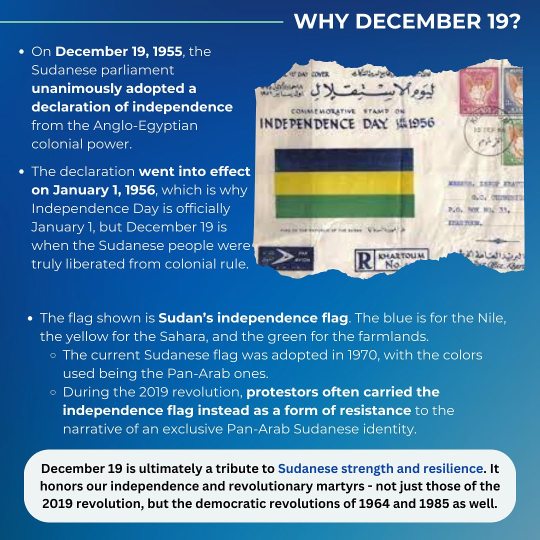
Transcript:
Why december 19?
On December 19, 1955, the Sudanese parliament unanimously adopted a declaration of independence from the Anglo-Egyptian colonial power.
The declaration went into effect on January 1, 1956, which is why Independence Day is officially January 1, but December 19 is when the Sudanese people were truly liberated from colonial rule.
The flag shown is Sudan's independence flag. The blue is for the Nile, the yellow for the Sahara, and the green for the farmlands.
The current Sudanese flag was adopted in 1970, with the colors used being the Pan-Arab ones.
During the 2019 revolution, protestors often carried the independence flag instead as a form of resistance to the narrative of an exclusive Pan-Arab Sudanese identity.
December 19 is ultimately a tribute to Sudanese strength and resilience. It honors our independence and revolutionary martyrs - not just those of the 2019 revolution, but the democratic revolutions of 1964 and 1985 as well.

Transcript:
Why is the revolution ongoing?
The goal was never just the fall of a dictator. The goal was, and is, to build a better Sudan, one free from military rule. One with equal opportunities for everyone, with economic prosperity and safety and security - the key principles of freedom, peace, and justice that the revolution called for.
Today, though, before we rebuild Sudan, before we free it from foreign interests and military rule and sectarianism, we need to save it. Each day that passes by with war waging on is one where more civilians are killed. More people are displaced. More women are raped. More children go hungry. To live in the conflict zones in Sudan right now - whether that be Khartoum, Darfur, Kordofan, or now, Al Gezira, is to be trapped in a never-ending nightmare, a fight for survival. And to live elsewhere in Sudan is to wonder whether you're next.
Sudan Action Week calls on you to educate yourself and others about Sudan, and then to help the Sudanese people save it, because we can no longer do it alone.
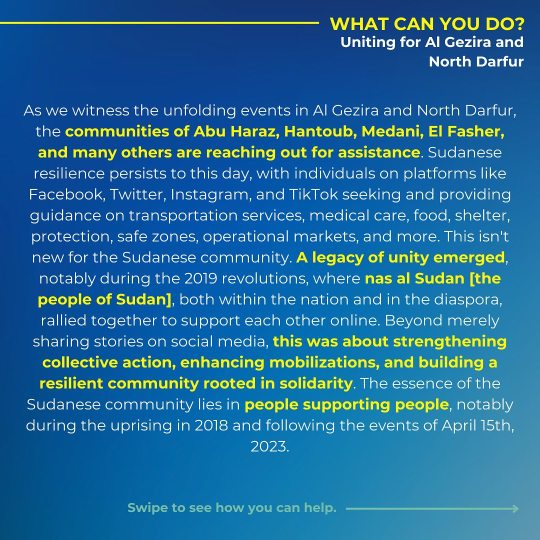
Transcript:
What can you do? Uniting for Al Gezira and North Darfur
As we witness the unfolding events in Al Gezira and North Darfur, the communities of Abu Haraz, Hantoub, Medani, El Fasher, and many others are reaching out for assistance. Sudanese resilience persists to this day, with individuals on platforms like Facebook, Twitter, Instagram, and TikTok seeking and providing guidance on transportation services, medical care, food, shelter, protection, safe zones, operational markets, and more. This isn't new for the Sudanese community. A legacy of unity emerged, notably during the 2019 revolutions, where nas al Sudan [the people of Sudan], both within the nation and in the diaspora, rallied together to support each other online. Beyond merely sharing stories on social media, this was about strengthening collective action, enhancing mobilizations, and building a resilient community rooted in solidarity. The essence of the Sudanese community lies in people supporting people, notably during the uprising in 2018 and following the events of April 15th, 2023
Swipe to see how you can help.
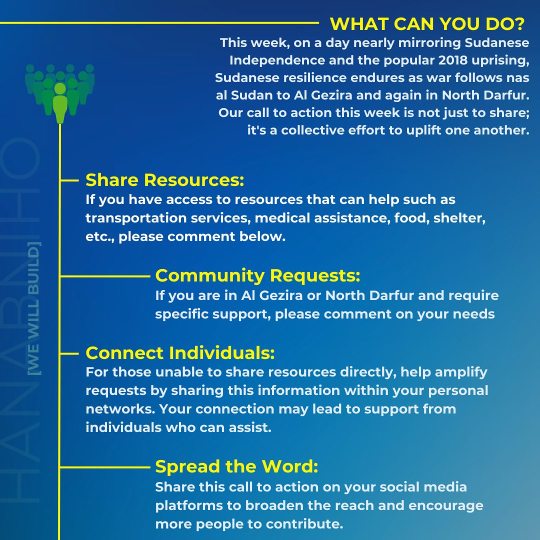
Transcript:
What can you do?
This week, on a day nearly mirroring Sudanese Independence and the popular 2018 uprising, Sudanese resilience endures as war follows nas al Sudan to Al Gezira and again in North Darfur. Our call to action this week is not just to share; it's a collective effort to uplift one another.
Share Resources:
If you have access to resources that can help such as transportation services, medical assistance, food, shelter, etc., please comment below.
Community Requests:
If you are in Al Gezira or North Darfur and require specific support, please comment on your needs
Connect Individuals:
For those unable to share resources directly, help amplify requests by sharing this information within your personal networks. Your connection may lead to support from individuals who can assist.
Spread the Word:
Share this call to action on your social media platforms to broaden the reach and encourage more people to contribute.
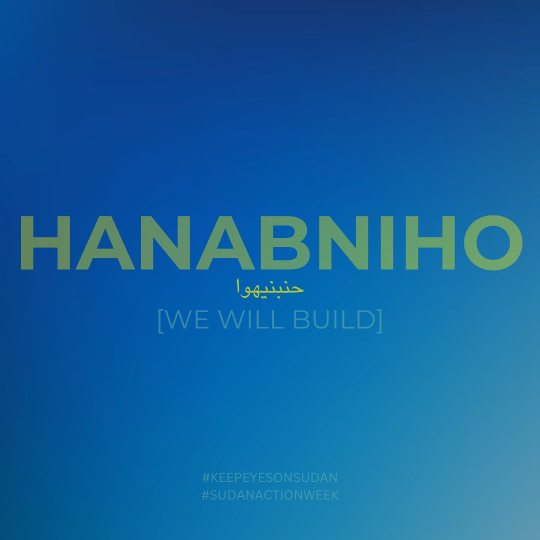
Transcript:
Hanabniho
حنبنيهوا
[We will rebuild]
#keepEyesOnSudan
#SudanActionWeek
924 notes
·
View notes
Text
CHF26,756 raised of CHF38,475 goal
‼️ 11,720 AWAY FROM GOAL
‼️ DONATIONS HAVE SLOWED!! Please donate if you can and share widely to help Eman and her family evacuate the genocide in Sudan!!!
Their house in Khartoum was bombed while they were still inside, and Eman lost her younger brother during this tragedy. They sought refuge with relatives further north in Sudan, but as the situation continues to deteriorate, they relatives can no longer afford to support them and they currently need a new place to live.
In April, the city of Atbara, where Eman and her family were looking to get their home rebuilt, had been bombed, so they are now looking to evacuate. Please donate if you can!! Remember that even $5 can make a difference ❤️
#urgent#important#donations#mutual aid#gofundme#gfm#aid#sudan crisis#sudan genocide#genocide#free sudan#keep eyes on sudan#all eyes on sudan#sudan fundraiser#sudan gofundme#sudanese gofundme#sudanese fundraiser#evacuation fundraiser#please donate
20 notes
·
View notes
Text
DONATIONS FOR SUDAN!!!!!
Please donate as much as you can for the people of Sudan!! if you can't donate try to share and spread awareness about this as well as the situation/genocide that is currently going on in Sudan!!
"We are currently providing Medical aid and food supplies Sharg An Neel, Karrari, Um Durman, Port Sudan, Atbara, Halfa and Dongola. We are targeting 43,000 + IDPs, 180,000+ Host Communities Cluster Targets and 30,000 + Host Communities Project Targets in Sudan"-excerpt from SAPA USA website.
#ceasefire now#stop the war#stop war#stop the hate#stop the genocide#free sudan#keep eyes on sudan#sudan genocide#sudan#sudan crisis#silent genocide#eyes on sudan#stoprape#stop terrorism against Sudane people#genocide#Donations#aid#please consider donating#donate#donate if you can#please donate#ramadan#muslims#resistance#ameen#alhamdulillah#stop genocide against Sudanese people
43 notes
·
View notes
Text
Sudan Tribune: Sudan flood death toll climbs to 148, aid access hampered

“August 28, 2024 (PORT SUDAN) – The death toll from floods in Sudan has reached 148, with 246 injured across 11 states, the National Council for Civil Defence said on Wednesday, as heavy rains continue to wreak havoc and hamper aid delivery.
The worst-hit states include River Nile with 59 fatalities, Northern state with 31, and Red Sea state with 16, according to spokesman Major General Qureshi Hussein.
Floods have washed away roads and bridges, including key routes like the Haya-Atbara and Merowe-Dongola highways, disrupting transportation and access to affected areas.
The civil defence has been conducting evacuations and providing shelter, food, and other essentials to displaced people.
Hussein denied reports of difficulties in recovering bodies from the Arba’at Dam area due to deep water, saying trained divers and equipment are on the ground.
Despite efforts to stabilize the situation in the Arba’at Dam and Tokar areas, the arrival of more water from the Cooper Dolabiyai region has submerged additional neighbourhoods, further compounding the crisis.
With roads cut off, aid delivery by land has become impossible, prompting calls for urgent airdrops of food, medicine, and shelter.
‘The situation in these areas is critical,’ Hussein warned.”
#sudan#keep eyes on sudan#sudanfloods#sudan floods#sudan tribune#sudan crisis#sudanese genocide#free sudan#sudan war#2024#labutansa
5 notes
·
View notes
Text
GWR 4100
i got behind on this series mainly because of these mf'ers
the 4100 class consists of 3 or 4... subclasses? (Badminton, Atbara, Flower, and Armstrong classes)
((the last of which is actually a small group of prototypes?))
via two designers? (Dean and Churchward)
there is a ton of variation in this group, but they all seem to be outside-framed 4-4-0s
over the course of 11 years (1897-1908) for a total of 80
and after all that to-do, they seem to have all been scrapped by around 1930
the distinctions between the classes and the rebuilding gets pretty technical... which, i guess the engineering would be getting kinda tricksy if you felt the need to made a prototype 4-4-0 as late as c. 1900, so, sure
i ain't learning all that. i'll just made a lil collection of pretty pictures and call it a day. lookit the size of these fireboxes relative to the rest of the engine!


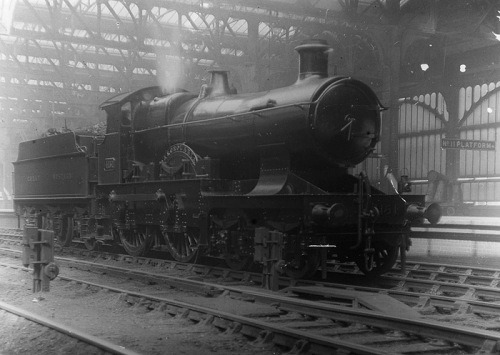






the final engine, 'Brunel', is one of the Armstrong prototypes. surprisingly for this wheel arrangement, Brunel is the only elegant one of the lot imo
(sourced from Wikipedia and GWR.ORG.UK)
#y'all know i love edward's furness background#but the nwr managing to snag one of the weirder less famous Armstrong prototypes would have been so fucking on-brand i just#trains!
13 notes
·
View notes
Text
From Streets to Symbols: Unveiling the Power of Graffiti, Art, Music, and Culture in Protest Movements – A Spotlight on the Sudanese Revolution
Have you ever found yourself associating a dance move with a particular era or linking a pose to a significant cultural moment? Such connections often transcend the boundaries of the physical, seeping into the realms of art, music, and cultural symbols. In Sudan, the evolution of symbols during the revolution was nothing short of poetic. The Sudanese revolution of 2019 serves as a compelling canvas where these forms of expression converged, giving rise to the Kandaka with the white toub—a powerful symbol of resistance that echoed the collective voices of a nation yearning for change.

Graffiti and Street Art as Voices on Walls
During Sudan’s 2019 revolution, as people mobilized across the country with sit-ins, marches, boycotts, and strikes, artists helped capture the country’s discontent and solidify protesters’ resolve (How Art Helped Propel Sudan’s Revolution, n.d.). What started as protests against rising food and fuel costs turned into a coup where millions marched to overthrow al-Bashir after 30 years in power.
Artists became an integral part of the months-long sit-in at the military headquarters in Khartoum, known as the heart of the revolution. This expression of creativity was both a result of loosening restrictions on freedom of expression and a catalyst for further change.
Artists throughout Sudan used graffiti to spur conversations about the trajectory of the country and also used murals to share information about dates and times of protests. Jonathan Pinckney, program officer and research lead for USIP’s program on nonviolent action, pointed out that art has played a role in many major nonviolent struggles to create a shared vocabulary (How Art Helped Propel Sudan’s Revolution, n.d.).

Hussein Merghani’s watercolor of hundreds of people from Atbara traveling to join the sit-in at the military headquarters in Khartoum in April 2019.

A mural by Galal Yousif near the sit-in site reads “you were born free, so live free.” (Sari Ahmed Awad)
Visual Arts and Popular Culture: The Kandaka and the White Toub:
In a society where patriarchy and male dominance prevail, it's quite surprising that a woman emerged as a symbol of protest. The kandake, breaking stereotypes, became an iconic figure, showcasing the resilience of Sudanese women who have long been leaders in the country’s revolutions. Since 1989, when Omar al-Bashir seized power, women faced curtailed rights under vaguely defined moral and penal codes, notably the 1991 Public Order Laws dictating women's public conduct, movement, and even clothing. Despite these oppressive measures, women persisted in their fight against al-Bashir's rule, playing a pivotal role in mobilizing protests.
This resilience found a remarkable face in a young student named Alaa Salah, captured in a moment of protest wearing a white toub and traditional jewelry. Standing atop a car, she passionately chanted revolutionary poetry, expressing the collective frustrations: “They imprisoned us in the name of religion, burned us in the name of religion … killed us in the name of religion,” met with the resounding response of “revolution” from the crowd (Ismail and Elamin 2019). This powerful image swiftly went viral in Sudan, becoming a catalyst for countless Sudanese artworks, ranging from political caricatures to paintings to graffiti on Khartoum's streets.
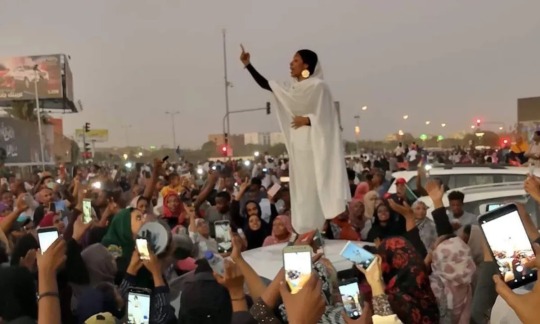
What makes this image truly iconic is the symbolism embedded in the white toub—a garment worn by women of all classes, considered a democratic attire that doesn't conform to strict piety rules promoted by Islamists. Urban upper- and middle-class women, by embracing the toub, transcended ethnic and social differences, actively promoting unity. The resonance of this image extended beyond its visual impact, inspiring a wave of artistic expressions that echoed the collective call for change on the streets of Khartoum.

The Digital Canvas: Social Media as the New Protest Wall
When delving into the role of digital communities and social media in amplifying protests, particularly within Sudan, one cannot overlook the pivotal role online communication played during the revolution. However, these efforts faced substantial hurdles due to government-initiated internet outages and blockages targeting key sites.
Despite these challenges, the #SudanUprising hashtag emerged as a crucial tool, enabling people to stay connected with the diaspora and providing a real-time feed of events. This hashtag echoed resoundingly across various digital platforms, effectively transforming cyberspace into a dynamic virtual protest ground.
As the Kandaka and the white toub began to capture hearts on social media, the digital realm evolved into a powerful conduit for spreading awareness and mobilizing global support. The viral nature of these symbols transcended geographical boundaries, forging a united global community in solidarity with Sudan's impassioned fight for justice. Journalists, activists, and human rights groups closely followed #SudanUprising, receiving updates in English, while international organizations such as the UN and Amnesty unequivocally condemned the attacks on the protesters.
During the persisting blackout, more details about the tragic June 3 attack unfolded, revealing a grim toll – over 100 lives lost, including 26-year-old engineer Mohamed Mattar. In a poignant tribute, Mattar’s family and friends changed their profile pictures to blue, his favorite color. This simple yet powerful act evolved into #BlueForSudan, swiftly transforming into a global movement to honor and stand in solidarity with all the victims.
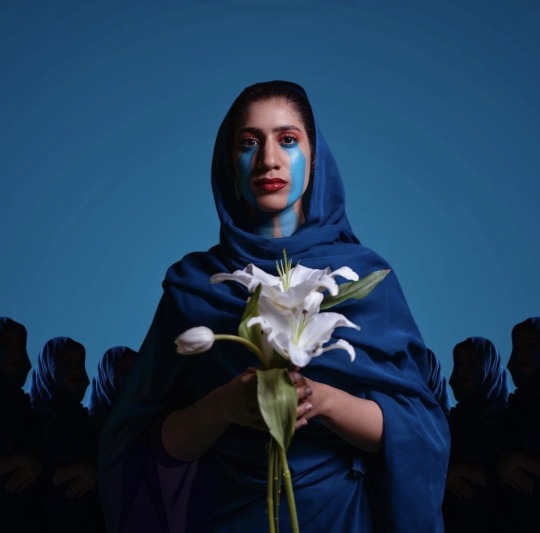
Renowned figures such as American singer and actress Rihanna and Nigerian artist Davido joined the chorus of celebrities and high-profile artists who utilized their platforms to shed light on the crisis, further propelling the momentum of awareness online. This vividly underscores the profound impact of virality in shaping public opinion and underscores the critical importance of social media in enhancing visibility and fostering global support for protests. The viral image of the Kandaka served as a catalyst, creating a wave that stirred widespread calls to action.

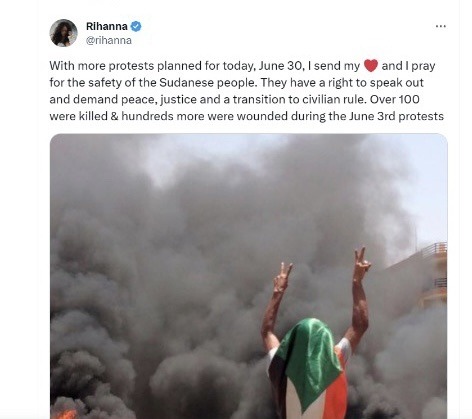
Navigating Change and Resilience Through the Digital Evolution of Expression
Looking back at how graffiti, art, music, and culture unfolded during the Sudanese revolution, it's clear these expressions aren't confined to physical spaces – they evolve and echo on digital stages. The Kandaka in the white toub isn't just an image; it's a powerful symbol, showing how art and culture shape stories and bring people together. In today's world, hashtags become anthems, and digital communities amplify calls for change. The Sudanese revolution teaches us about the enduring strength of creativity in tough times. The Kandaka's journey from streets to screens, from local to global, shows us how art can spark change and resilience in the face of challenges.
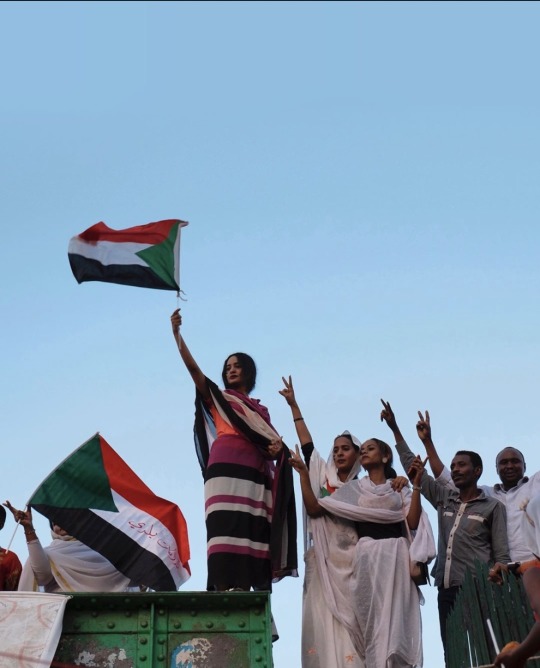
References
How art helped propel Sudan’s revolution. (n.d.). United States Institute of Peace. https://www.usip.org/blog/2020/11/how-art-helped-propel-sudans-revolution
Roussi, A., & Lonardi, M. (2021, July 6). Art on the front lines of a changing Sudan. Al Jazeera. https://www.aljazeera.com/features/2021/6/30/art-on-the-front-lines-of-a-changing-sudan
From white Teyab to pink Kandakat: Gender and the 2018-2019 Sudanese Revolution. (n.d.). Journal of Public and International Affairs. https://jpia.princeton.edu/news/white-teyab-pink-kandakat-gender-and-2018-2019-sudanese-revolution
#mda20009#sudaneserevolution#2019sudanuprising#digitalcitiziship:protest#digitalcitizinship:activism
1 note
·
View note
Text
'[...]had I asked one of them to rent me a room in his house he would as likely as not have refused, and were his daughter to tell him she was going to marry this African, he'd have felt that the world was collapsing under his feet. Yet each one of them in that court would rise above himself for the first time in his life, while I had a sort of feeling of superiority towards them, for the ritual was being held primarily because of me; and I, over and above everything else, am a coloniser, I am the intruder whose fate must be decided. When Mahmoud Wad Ahmed was brought in shackles to Kitchener after his defeat at the Battle of Atbara, Kitchener said to him, "Why have you come to my country to lay waste and plunder?" It was the intruder who said this to the person whose land it was, and the owner of the land bowed his head and said nothing. So let it be with me. In that court I hear the rattle of swords in Carthage and the clatter of the hooves of Allenby's horses desecrating the ground of Jerusalem. The ships at first sailed down the Nile carrying guns not bread, and the railways were originally set up to transport troops; the schools were started so as to teach us how to say "Yes" in their language. They imported to us the germ of the greatest European violence, as seen on the Somme and at Verdun, the like of which the world has never previously known, the germ of a deadly disease that struck them more than a thousand years ago. Yes, my dear sirs, I came as an invader into your very homes: a drop of the poison which you have injected into the veins of history.
'I am no Othello. Othello was a lie.'
Tayeb Salih, Season of Migration to the North
1 note
·
View note
Text
KHARTOUM, May 2 (Reuters) - Sudan's warring military factions agreed to a new and longer seven-day ceasefire from Thursday, neighbour and mediator South Sudan said, even as more air strikes and shooting in the Khartoum capital region undercut their latest supposed truce.
Previous ceasefire pledges have ranged from 24 to 72 hours but there have been constant truce violations in the conflict that erupted in mid-April between the army and a paramilitary force.
South Sudan's foreign ministry said in a statement on Tuesday that mediation championed by its president, Salva Kiir, had led both sides to agree a weeklong truce from Thursday to May 11 and to name envoys for peace talks. The current ceasefire was due to expire on Wednesday.
It was unclear, however, how army chief General Abdel Fattah al-Burhan and paramilitary Rapid Support forces (RSF) leader General Mohamed Hamdan Dagalo would proceed.
On Tuesday, witnesses reported more air strikes in the cities of Omdurman and in Bahri, both on the opposite bank of the Nile River from Khartoum.
Al Jazeera television said Sudanese army warplanes were targeting RSF positions, and anti-aircraft fire could be heard from Khartoum.
India's embassy in Khartoum was stormed and looted, Sudan's army said in a statement, citing a report from the ambassador. Saudi Arabia's foreign ministry said early on Wednesday that the building in Khartoum that houses its cultural mission was similarly vandalised and looted by an armed group. No casualties were reported.
Army jets have been bombing RSF units dug into residential districts of the capital region. Conflict has also spread to Sudan's western Darfur region where the RSF emerged from tribal militias that fought alongside government forces to crush rebels in a brutal civil war dating back 20 years.
The commanders of the army and RSF, who had shared power as part of an internationally backed transition towards free elections and civilian government, have shown no sign of backing down, yet neither seems able to secure a quick victory.
REGION AT RISK
Prolonged conflict could draw in outside powers.
Fighting now in its third week has engulfed Khartoum - one of Africa's largest cities - and killed hundreds of people. Sudan's Health Ministry reported on Tuesday that 550 people have died and 4,926 injured.
Foreign governments were winding down evacuation operations that sent thousands of their citizens home. Britain said its last flight would depart Port Sudan on the Red Sea on Wednesday and urged any remaining Britons wanting to leave to make their way there.
The conflict has also created a humanitarian crisis, with around 100,000 people forced to flee with little food or water to neighbouring countries, the United Nations said.
Aid deliveries have been held up in a nation where about one-third of people already relied on humanitarian assistance. A broader disaster could be in the making as Sudan's impoverished neighbours grapple with a refugee influx.
"The entire region could be affected," Egyptian President Abdel-Fattah al-Sisi said in a Japanese newspaper interview on Tuesday as a Burhan envoy met Egyptian officials in Cairo.
The U.N. World Food Programme said on Monday it was resuming work in the safer parts of Sudan after a pause earlier in the conflict, in which some of its staff were killed.
'THE SITUATION IS A CALAMITY'
Medecins Sans Frontieres (MSF) said it had delivered some aid to the capital from Port Sudan, a road journey of about 800 km (500 miles).
Some 330,000 Sudanese have also been displaced inside Sudan's borders by the war, the U.N. migration agency said.
"The situation is a calamity," Hassan Mohamed Ali, a 55-year-old state employee, said during a stopover in Atbara, 350 km (220 miles) northeast of Khartoum, en route to the Egyptian frontier.
"We suffer from power and water cuts, our children have stopped school. What's happening in Khartoum is hell."
Displaced Sudanese families have also made their way, sometimes on foot under scorching desert sun, hundreds of kilometres (miles) to Chad and South Sudan.
About 800,000 people could eventually leave, according to the U.N.
More than 40,000 people have crossed the border into Egypt over the past two weeks but only after days of delays. Most migrants have had to pay hundreds of dollars to make the 1,000-km (620-mile) journey north from Khartoum.
It took Aisha Ibrahim Dawood and her relatives five days in a rented car to get from Khartoum to the northern town of Wadi Halfa, where the women and children crammed into a back of a truck that brought them to a queue at the Egyptian border.
"Our suffering is unprecedented," she said.
1 note
·
View note
Text

Exporter of Belt Conveyor In Sudan
R Mech Machines LLP, established in 2008 in Ahmedabad, Gujarat, India, has emerged as a global leader in manufacturing, supplying, and exporting of Belt Conveyor In Sudan and other related products.
The main purpose of our belt conveyors is material handling. Either the side working tables or the conveyor belt can be used for quick assembly.
We construct conveyors depending on the process requirements as well as the load weight and size of the various commodities that must be transported.
The Types of Belt Conveyors
Roller Bed Conveyor Belts
Flat Belt Conveyors
Modular Belt Conveyors
Cleated Belt Conveyors
Curved Belt Conveyors
Incline/Decline Belt Conveyors
Sanitary and Washdown Conveyors
Specialty Conveyor Belts
Specification
Usage/Application: Industrial
Belt Width: 600 mm
Brand: R Mech
Belt Thickness: 10 mm
Features: Heat, Chemical Resistant
Finish: Color Coated
Load Capacity(Kg): 180 kg/Feet
Voltage: 240 V
Automation Grade: Semi Automatic
Voltage (Volt): 220/380 V
Body Material: Mild Steel
Belt Material: Rubber
Frequency: 50-60 Hz
Features
Low energy consumption
High reliability and less maintenance
Heavy duty idlers with anti-friction bearings to increase idler life and reduce horsepower requirements
Heavy duty frames and structural supports to provide system rigidity
Easy to install
Zero speed switch
Our Belt Conveyors are used for grains, fertilizer, aggregate, cement, chemical, mining conveying and elevating.
RMech Machines LLP is Exporter of Belt Conveyor In Sudan and various locations like
Khartoum, Omdurman, Khartoum North, Port Sudan, Kassala, Al-Ubayyid, Al-Fashir, Wad Madani, El Geneina, Atbara, Dongola, Rabak, Sennar, Kaduqli, Ed Damer, El Obeid, Medani, Kosti, El Fasher.
If you are interested in our high-quality products, please do not hesitate to reach out to us for further information.
0 notes
Text
City Class: 3700 Durban
Formerly Atbara Class - 3400 'Durban' | True Name: Carys
Eldest of the Great Western, City Class. Doting, kind and loving towards his younger siblings but especially Truro. Durban coddles and spoils Truro so much that it often puts Truro at odds with his other siblings, making him a target.
Durban turns a blind eye to Truro and his friends' recklessness because of his forgiving and doting nature towards the younger City Class.
15 notes
·
View notes
Photo

Croisière sur le Nil en Felouque - Égypte
Les bras du Nil
Après la confluence du Nil Bleu et du Nil Blanc, le seul affluent principal restant est la rivière Atbara, qui prend sa source en Éthiopie, à environ 50 km au nord du lac Tana, et coule sur approximativement 800 km. Elle rejoint le Nil environ 300 km après Khartoum. Le Nil a ainsi comme particularité que son dernier affluent le rejoint à mi-chemin de la mer. Après cette dernière confluence, le débit du Nil diminue en raison de l'évaporation très importante lors de la traversée du Sahara.
Le Nil au Soudan présente deux particularités :
il s'écoule par six groupes de cataractes, de Sbakola (au nord de Khartoum) jusqu'à Assouan ;
il fait ponctuellement demi-tour, retournant vers le sud-ouest avant de couler plus directement vers la mer, formant ainsi le grand méandre du Nil.
Au nord du Caire, le Nil rejoint la Méditerranée par un delta à l'entrée duquel il se divise en deux bras principaux, le bras de Rosette à l'ouest et celui de Damiette à l'est.
0 notes
Text
Everything You Need To Know About The World's Longest Rivers
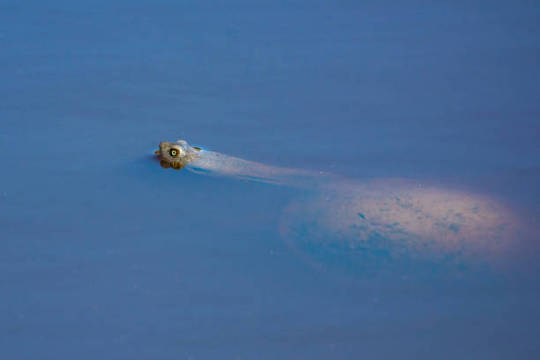
Amazon and Nile are the longest rivers around the globe, and the Amazon is the largest in water volume of any river on earth. The Amazon is responsible for one fifth of freshwater that enters the oceans. Read on to learn more about these incredible waters.
Yangtze River
The Yangtze River runs through China and covers an area of 3.7 million square miles. Its drainage area provides water and food for the approximately 400 million inhabitants. The longest rivers in the world is also a major transportation artery connecting China's interior with the coastline. Its flow is one of the biggest in the world , and it transports a wide range of products, including coal, manufactured products, and passengers. The river carried 795 million tonnes of cargo in 2005.
The Yangtze River rises in the Tanggula Mountains and flows 3,900 miles to the East China Sea. The image was taken by the Copernicus Sentinel-2 satellite near the city of Chongqing. This image illustrates how the levels of water are declining due to rising temperatures. Rivers are losing water and sediments that are rising to sea levels. This can be seen in western portion of the river.
Amazon River
The Amazon River, a glacial river, is a part of Peru's Andes. It measures six and a quarter thousand miles long, which makes it the longest rivers in the world. The origins of the river aren't entirely clear. Scientists think that the Amazon's glacial river is the consequence of Nevado Mismi (a mountain in Peruvian Andes).
The length of the Amazon River is the result of several tributaries, including the Para River and the Northern Amazon River Channel. The two channels, also known as"furo, "furo," connect the Amazon to the Atlantic Ocean. This allows you to visit the Amazon's mouth and is geographically bizarre.
Nile River
The Nile River flows 6,600 km and empties into Mediterranean Sea. The Nile longest river has served as a major source of irrigation and transportation for thousands upon many thousands of years. It remains an important waterway. Families still gather water from the river's banks, and you can see the ancient Egyptian ruins along its banks.
Three main streams form the Nile River. The Blue Nile rises in Ethiopia The Atbara comes from the mountains of Ethiopia, and the White Nile starts in Lake Victoria.
Summary:
These photos offer a unique view of the changes that rivers face due to changes in the climate. Each photo tells a tale of how river health can be affected through changes in water levels and sedimentation or temperatures. Copernicus Sentinel-2 satellite missions provides important information on the global climate shift. This can aid in understanding why our world is changing.
0 notes
Text
DONATIONS FOR SUDAN!!!!!
Please donate as much as you can for the people of Sudan!! if you can't donate try to share and spread awareness about this as well as the situation/genocide that is currently going on in Sudan!!
"We are currently providing Medical aid and food supplies Sharg An Neel, Karrari, Um Durman, Port Sudan, Atbara, Halfa and Dongola. We are targeting 43,000 + IDPs, 180,000+ Host Communities Cluster Targets and 30,000 + Host Communities Project Targets in Sudan"-excerpt from SAPA USA website.
#ceasefire now#stop the war#stop war#stop the hate#stop the genocide#free sudan#keep eyes on sudan#sudan genocide#sudan#sudan crisis#silent genocide#eyes on sudan#stoprape#stop terrorism against Sudane people#genocide#Donations#aid#please consider donating#donate#donate if you can#please donate#ramadan#muslims#resistance#ameen#alhamdulillah#stop genocide against Sudanese people
15 notes
·
View notes
Text
The Bidwell houses at Gallop Road
The Bidwell houses at Gallop Road
Two beautiful conservation houses, Atbara and Inverturret at No 5 and No 7 Gallop Road, grace the newly opened Singapore Botanic Gardens Gallop Extension. Both wonderfully repurposed, Atbara as the Forest Discovery Centre and Inverturret as the Botanical Art Gallery, they are among the oldest and finest surviving examples of residential properties that English architect Regent Alfred John (R A J)…

View On WordPress
#5 Gallop Road#7 Gallop Road#Architecture#Atbara#Black and White Houses#Botanics#Changing Landscapes#Colonial Architecture#Colonial Residences#Colonial Singapore#Forgotten Places#Gallop Extension#Gallop Road#Inverturret#Kuala Lumpur#Old Places#Old Singapore#Photographs#Photography#RAJ Bidwell#Singapore#Singapore Botanic Gardens#Singapore Botanic Gardens Gallop Extension#Sultan Abu Samad Building#Swan and MacLaren#Turn of#Turn of 20th Century Colonial Architecture
3 notes
·
View notes